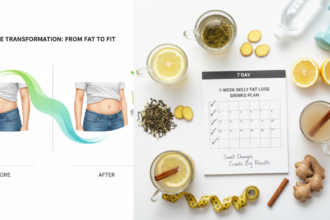Transforming your body isn’t just about hitting the gym or cutting carbs—it’s a holistic journey involving mindset, science, and strategy. At iofbodies.com, we believe in empowering you with real, sustainable techniques to reshape your physique and lifestyle. Let’s dive into 15 powerful strategies to help you unlock your full potential and achieve results that stick.
1. Understanding Body Transformation Basics
Before you dive into workouts and diet plans, it’s essential to understand what “body transformation” truly entails. It’s not just about losing fat or gaining muscle—it’s about reshaping your body composition and improving overall health.
What it includes:
- Reducing body fat percentage
- Increasing lean muscle mass
- Enhancing metabolic health
- Improving mental well-being
Why it matters:
When you understand the full picture, you’re more likely to stay committed and avoid fad approaches that lead to burnout or injury.
2. Setting SMART Fitness Goals
Goals provide direction. Without them, you’re just wandering in the gym or kitchen.
SMART Goals:
- Specific: “Lose 10 lbs” vs. “Get fit”
- Measurable: Trackable metrics like weight, body fat, reps
- Achievable: Set realistic milestones
- Relevant: Align with your lifestyle and health
- Time-bound: Set deadlines to stay accountable
💡 Tip: Use apps like MyFitnessPal or iofbodies .com’s goal tracker to keep you on target.
3. Importance of Personalized Workout Plans
No two bodies are the same—why should workouts be?
Customized workouts take into account:
- Fitness level
- Injuries or health conditions
- Preferences (HIIT vs. lifting vs. yoga)
- Lifestyle constraints
Personalization increases adherence and lowers the risk of injury, helping you stay consistent.
4. Nutrition: Fueling Your Body for Change
You can’t out-train a poor diet. Nutrition plays a key role in transforming your body.
Focus on:
- Whole foods over processed junk
- Balanced macros (carbs, proteins, fats)
- Nutrient-dense vegetables and fruits
- Meal timing (especially post-workout)
📌 Keyword Tip: Incorporate “body transformation diet plan” and “nutrition for fat loss” naturally throughout your routine.
5. Role of Macros in Body Composition
Your body’s shape is largely determined by how you balance your macronutrients.
Macro Breakdown:
| Macro | Purpose | Daily Ratio (General) |
|---|---|---|
| Protein | Muscle repair and growth | 25–35% |
| Carbohydrates | Energy source | 40–50% |
| Fats | Hormone production and absorption | 20–30% |
Tracking macros can be a game-changer in refining your transformation process.
6. Hydration and Its Hidden Power
Hydration is often overlooked, yet it’s critical for metabolism, digestion, and even fat loss.
Benefits of staying hydrated:
- Supports nutrient transport
- Aids muscle recovery
- Boosts energy levels
- Enhances fat oxidation
💧 Drink Tip: Aim for at least 3 liters of water daily—more if you’re training intensely.
7. Cardiovascular vs. Strength Training
Both cardio and strength training have their place in your fitness plan.
| Training Type | Benefits | Best For |
|---|---|---|
| Cardio | Improves endurance, burns calories | Fat loss, heart health |
| Strength | Builds muscle, boosts metabolism | Body shaping, strength |
A hybrid approach often yields the best body transformation results.
Would you like me to continue writing the rest of the article with all 15 sections, FAQs, and the conclusion?
4o
8. The Significance of Progressive Overload
Progressive overload is the foundation of muscle growth and strength gain. Without it, your body adapts, and progress stalls.
What it means:
Gradually increasing the stress placed on your muscles over time through:
- Heavier weights
- More reps or sets
- Reduced rest between sets
- Better form and mind-muscle connection
💡 Pro Tip: Track your lifts weekly using a fitness journal or app to ensure steady progression.
9. Recovery: Sleep, Rest Days, and Stress Management
Recovery is where your body rebuilds and grows. Skipping it is like skipping half your transformation.
Key recovery strategies:
- Sleep: Aim for 7–9 hours/night for optimal hormone balance and muscle repair.
- Rest Days: Schedule at least 1–2 per week to prevent burnout.
- Stress Management: Chronic stress spikes cortisol, which promotes fat storage and muscle breakdown.
🌿 Try This: Yoga, meditation, or a nature walk to recharge mentally and physically.
10. Supplements: Do You Really Need Them?
Supplements can support your goals, but they’re not magic pills.
Useful supplements:
- Protein powders – For hitting daily protein targets
- Creatine monohydrate – Improves strength and muscle gains
- Multivitamins – Fills nutritional gaps
- Fish oil – Supports joint and heart health
🛑 Beware of gimmicks: Fat burners and detox teas are often overhyped and under-deliver.
📎 Examine.com is a great resource to learn more about supplement science.
11. Tracking Progress: Metrics That Matter
Transformation is more than just weight loss. You need multiple tools to see the full picture.
Track these:
- Body fat percentage
- Girth measurements (waist, hips, chest)
- Progress photos (monthly)
- Strength improvements
- Energy and sleep quality
📱 Digital Help: Use tools like Fitbit, Renpho Smart Scales, or the iofbodies .com tracker.
12. Mental Fitness: Staying Motivated and Focused
Physical transformation starts in the mind. If your head’s not in it, your body won’t follow.
Mindset tips:
- Visualize success
- Journal your journey
- Celebrate small wins
- Avoid perfectionism
👊 Stay Inspired: Follow fitness influencers who align with your values—not just aesthetics.
13. Overcoming Plateaus
Plateaus are frustrating—but also a sign you’ve adapted and need to level up.
Break through with:
- Changing training intensity or frequency
- Adjusting calories/macros
- Trying new workout styles (e.g., CrossFit, Pilates)
- Prioritizing sleep and recovery
🌀 Cycle Tip: Consider a deload week every 6–8 weeks to give your body and mind a reset.
14. Hiring a Coach vs. DIY Fitness
Should you go solo or get expert guidance?
| Option | Pros | Cons |
|---|---|---|
| DIY | Budget-friendly, flexible | Risk of poor form or slow results |
| Coach | Personalized plans, accountability | Higher cost |
✅ Best of both worlds: Start DIY with solid resources (like iofbodies .com), then invest in a coach if you hit a wall.
15. Real Transformation Stories from iofbodies .com
Nothing motivates like real people making real change.
Examples:
- Sarah (32) lost 45 lbs and built muscle using our macro coaching and strength program.
- Alex (29) reversed prediabetes through our low-carb nutrition plan.
- Maria (47) sculpted lean muscle with 3x/week strength training and daily mindset journaling.
🔁 Want to share your story? Submit your progress to be featured on iofbodies .com.
H2: FAQs
Q1: How long does a body transformation take?
A: It varies. Most people see visible changes in 8–12 weeks, but lasting results typically take 6 months to a year, depending on goals and consistency.
Q2: What’s more important: diet or exercise?
A: Both matter. But if you had to pick one, nutrition has the edge—you can’t out-train a poor diet.
Q3: How do I stay motivated long-term?
A: Set short-term goals, track progress, and celebrate small wins. Surround yourself with positive support and revisit your “why” regularly.
Q4: Is it normal to gain weight when starting strength training?
A: Yes! Muscle is denser than fat. The scale may go up, but your body is becoming leaner and stronger.
Q5: How many times a week should I work out?
A: Aim for at least 3–5 times per week. Mix cardio, strength, and flexibility to keep things balanced and interesting.
Q6: Can I transform my body at any age?
A: Absolutely. Age is just a number—what matters is consistency, recovery, and smart training tailored to your body.
Conclusion
Body transformation is a journey—a rewarding one when approached with the right knowledge, mindset, and tools. Whether you’re looking to build muscle, burn fat, or simply feel better in your own skin, the strategies in this guide will set you on the path to real, sustainable results.
At iofbodies .com, we’re here to support your transformation every step of the way. Bookmark this guide, revisit it often, and remember—you’ve got this.






